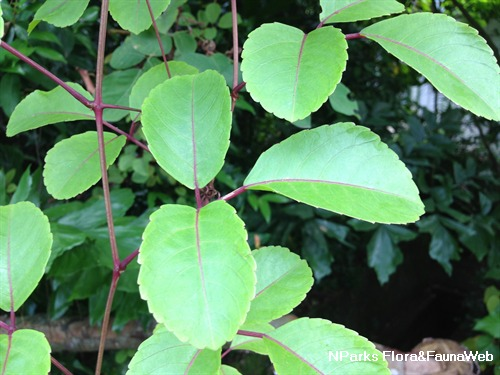Causonis trifolia


Common Name: three-leaved cayratia
Family: Vitaceae
Common Synonyms: Cayratia trifolia
USDA Hardiness Zone: NA
Growth Habit: Vine
Origin: Australia, S Pacific, India, SE Asia, possibly Africa
FISC Category: -
FDACS Listed Noxious Weed: No
Introduction Date: December 2017 in two Lee County parks.
IFAS Assessment:

Scrambling evergreen woody vine, can grow over 20m long in native range. Runs along ground and climbs trees and shrubs, smothering with time. Uses tendrils ending in suction pads to attach to vegetation and structures.. Leaves trifoliate, terminal leaflet usually longer. Leaflets 2.5-6 x 2-3.5 cm, ovate or elliptic, base cuneate or rounded, margin blunt serrate appearing crenate, apex acute or obtuse, thin-coriaceous, petiole to 6 cm long. Flowers ca. 4mm diameter, 4-lobed cup-shaped caylx, ca. 0.5cm long. Petals ca. 2.5mm long, outer surface with hairs. Flowers born in leaf axils, umbellate or corymbose cymes. Peduncle to 8 cm long. Petals 4, greenish-white, 1.5-2 mm long. Disk white. Stamens 4, filaments ca. 1 mm long. Fruits similar to muscadine grape, but depressed globose, purplish-black when mature, ca. 8-10mm high by 10-1.9mm wide. Seeds 1-4 per fruit.
Non-pyric communities.
Closely related to another invasive vine Cayratia japonica (bushkiller), which has invaded AL, CA, LA, MS, NC and TX in the continental US.Native to a large range in the old world, moved across globe for use as a medicinal plant. Vine introduced to Hawaii. Prefers full sun, moderate drainage. Fast grower. Flowers are visited by bees and butterflies, and fruits eaten by birds dispersing seeds in droppings.

Basal bark applications likely difficult due to woody vine base being somewhat decumbent.
Wunderlin, R. P., B. F. Hansen, A. R. Franck, and F. B. Essig. 2018. Atlas of Florida Plants (http://florida.plantatlas.usf.edu/).[S. M. Landry and K. N. Campbell (application development), USF Water Institute.] Institute for Systematic Botany, University of South Florida, Tampa.
Australian Tropical Rainforest Plants profile for Cayratia trifolia (http://keys.trin.org.au/key-server/data/0e0f0504-0103-430d-8004-060d07080d04/media/Html/taxon/Cayratia_trifolia.htm)
Singapore National Parks Flora and Fauna Web weppage for Cayratia trifolia (https://florafaunaweb.nparks.gov.sg/special-pages/plant-detail.aspx?id=5148)
